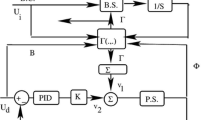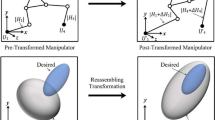Abstract
The Linked Multicomponent Robotic Systems are characterized by the existence of a non-rigid linking element. This linking element can produce many dynamical effects that introduce perturbations of the basic system behavior, different from uncoupled systems. We show through a simulation of a distributed control of a hose tranportation system, that even a minimal dynamical feature of the hose (elastic forces oppossing stretching) can produce significant behavior perturbations.
Access this chapter
Tax calculation will be finalised at checkout
Purchases are for personal use only
Preview
Unable to display preview. Download preview PDF.
Similar content being viewed by others
References
Duro, R.J., Graña, M., de Lope, J.: On the potential contributions of hybrid intelligent approaches to multicomponent robotic system development. Information Sciences (2010) (in press)
Echegoyen, Z., Villaverde, I., Moreno, R., Graña, M., d’Anjou, A.: Linked multi-component mobile robots: modeling, simulation and control. In: Robotics and Autonomous Systems (submitted 2010)
Echegoyen-Ferreira, Z.: Contributions to Visual Servoing for Legged and Linked Multicomponent Robots. PhD thesis, UPV/EHU (2009)
Graña, M., Torrealdea, F.J.: Hierarchically structured systems. European Journal of Operational Research 25, 20–26 (1986)
Huang, L.: Speed control of differentially driven wheeled mobile robots: Model-based adaptive approach. Journal of Robotic Systems 22(6), 323–332 (2005)
Klancar, G., Skrjanc, I.: Tracking-error model-based predictive control for mobile robots in real time. Robotics and Autonomous Systems 55, 460–469 (2007)
Koh, K.C., Cho, H.S.: A smooth path tracking algorithm for wheeled mobile robots with dynamic constraints. Journal of Intelligent and Robotic Systems 24, 367–385 (1999)
Liu, N.: Intelligent path following method for nonholonomic robot using fuzzy control. In: Second International Conference on Intelligent Networks and Intelligent Systems (2009)
McLain, T.W., Beard, R.W.: Coordination variables, coordination functions, and cooperative timing missions. AIAA Journal of Guidance, Control, & Dynamics 28(1), 150–161 (2005)
Oriolo, G., De Luca, A., Vendittelli, M.: Wmr control via dynamic feedback linearization: Design, implementation, and experimental validation. IEEE Trans. Control Systems Technology 10(6), 835–852 (2002)
Raimondi, F.M., Melluso, M.: A new fuzzy robust dynamic controller for autonomous vehicles with nonholonomic constraints. Robotics and Autonomous Systems 52, 115–131 (2005)
Ren, W., Beard, R.W.: Distributed Consensus in Multi-Vehicle Cooperative Control: Theory and Applications. Springer, Heidelberg (2007)
Shi-Cai, L., Da-Long, T., Guang-Jun, L.: Formation control of mobile robots with active obstacle avoidance. Acta Automatica Sinica 33(5), 529–535 (2007)
De La Nava, I.V.: On Computational Intelligence Tools for Vision Based Navigation of Mobile Robots. PhD thesis, UPV/EHU (2009)
Author information
Authors and Affiliations
Editor information
Editors and Affiliations
Rights and permissions
Copyright information
© 2010 Springer-Verlag Berlin Heidelberg
About this paper
Cite this paper
Fernandez-Gauna, B., Lopez-Guede, J.M., Zulueta, E. (2010). Linked Multicomponent Robotic Systems: Basic Assessment of Linking Element Dynamical Effect. In: Graña Romay, M., Corchado, E., Garcia Sebastian, M.T. (eds) Hybrid Artificial Intelligence Systems. HAIS 2010. Lecture Notes in Computer Science(), vol 6076. Springer, Berlin, Heidelberg. https://doi.org/10.1007/978-3-642-13769-3_9
Download citation
DOI: https://doi.org/10.1007/978-3-642-13769-3_9
Publisher Name: Springer, Berlin, Heidelberg
Print ISBN: 978-3-642-13768-6
Online ISBN: 978-3-642-13769-3
eBook Packages: Computer ScienceComputer Science (R0)




